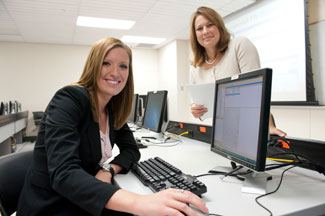Posted on February 7, 2018 by Joanna Carver
 This month, Beebe was named by Texas Monthly as one of “15 Innovators Reshaping Texas.” As one of the leaders of the cyber security revolution in San Antonio, Beebe is engaged in several research projects, including one for the U.S. Department of Homeland Security that is aimed at strengthening insider threat detection. She also oversees the UTSA Cyber Center for Security and Analytics, part of one of the most highly-regarded cyber security programs in the country.
This month, Beebe was named by Texas Monthly as one of “15 Innovators Reshaping Texas.” As one of the leaders of the cyber security revolution in San Antonio, Beebe is engaged in several research projects, including one for the U.S. Department of Homeland Security that is aimed at strengthening insider threat detection. She also oversees the UTSA Cyber Center for Security and Analytics, part of one of the most highly-regarded cyber security programs in the country.
We sat down with Dr. Beebe to learn about new developments in cybersecurity.
What is the most important thing happening in your field that no one is talking about but should be?
I’m not suggesting no one is talking about this, but surely not enough people are talking about the impending disaster of a teacher shortage in cyber security. The field is frequently highlighting the roughly two million workforce shortage in cyber security that we will all be feeling the effects of in two to three years. And, we are doing a good job at getting students interested in cyber security, as evidenced by the exploding enrollments in cyber security at UTSA and other universities.
But what people aren’t talking about enough, and what we are already experiencing, is a shortage of quality folks at all levels to train and educate students in cyber security. It’s a real issue, and with negative unemployment in cyber security and folks earning very high wages outside of education, it is hard to recruit folks to teach.
How does interdisciplinary work help research efforts in your field?
Interdisciplinary work doesn’t just help research efforts in cyber security, it’s a flat-out necessity. Cyber security is an extremely diverse field from highly technical sub-domains like cryptography, access control and digital forensics to non-tech domains such as law, policy, behavior and risk.
Not only is the field wide, both the threats and our defenses are multi-dimensional - solutions brought to bear from the perspective of only one discipline leave gaping holes in security. You can’t truly solve cyber security challenges without interdisciplinary collaboration and solutions.
Have you had any mentors? How does their guidance inform what you do now?
I have had the great fortune of many mentors over the years. Some have been specifically cyber security-oriented. Others have been professional or personal mentors. Mentors are very important - whether formal or simply successful people you identify to “study” and emulate. When you pay attention to successful people and take the time to really understand why they’re successful, you can learn a great deal.
What advice do you have for this generation of students?
Get involved and make cyber security an intellectual hobby and social club. There are so many opportunities for students to engage in cyber security with others outside the classroom, from competitions and challenges, to clubs, meet-ups, blogs and boards.
What makes The Cyber Center for Security & Analytics unique?
We pride ourselves on our strong relationship with researchers across a wide variety of disciplines both internal and external to UTSA. This allows us to leverage the gamut of cyber and analytics subject matter expertise as we tackle real-world problems. Our multi-disciplinary approach to developing high-impact, applied research brings together great minds from fields such as business, cyber security, information systems, computer science, electrical and computer engineering, mechanical engineering, statistics, management science, criminal justice, psychology and others. These partnerships really help us affect change for industry and government partners and enhance UTSA’s educational programs in cyber and analytics.

